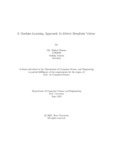| dc.contributor.advisor | Rahman, Md. Khalilur | |
| dc.contributor.advisor | Alam, Md. Golam Rabiul | |
| dc.contributor.author | Hassan, Md. Mahedi | |
| dc.contributor.author | Nawrin, Na sha | |
| dc.date.accessioned | 2021-12-26T05:00:07Z | |
| dc.date.available | 2021-12-26T05:00:07Z | |
| dc.date.copyright | 2021 | |
| dc.date.issued | 2021-06 | |
| dc.identifier.other | ID 17301098 | |
| dc.identifier.other | ID 20241064 | |
| dc.identifier.uri | http://hdl.handle.net/10361/15754 | |
| dc.description | This thesis is submitted in partial fulfillment of the requirements for the degree of Bachelor of Science in Computer Science and Engineering, 2021. | en_US |
| dc.description | Cataloged from PDF version of thesis. | |
| dc.description | Includes bibliographical references (pages 32-35). | |
| dc.description.abstract | DeepFake detection is important as the internet is a big part of our lives. DeepFake
photos and videos can easily mislead us into thinking something that probably did
not happen. It can also reduce trust in the media. As these manipulations become
more convincing, celebrities are usually the victim of these kinds of misleading
photos and videos. To detect fake videos, we will focus on existing methods and
build our model to be more accurate as images of small imperceptible perturbations
are su cient to fool the most powerful neural network. In our Machine Learning
approach, we rst take the sample videos for training. Then, using open CV2, we
have generated images from those videos. After that, we have passed these images
to PCA for extracting principal component features. Then we applied VGG-16 and
nally we have compared the train-test accuracy using di erent classi ers like SVC,
RFC, GNB, CNN etc. After analyzing through our model we will be able to infer
whether the input video is real or fake. | en_US |
| dc.description.statementofresponsibility | Md. Mahedi Hassan | |
| dc.description.statementofresponsibility | Na sha Nawrin | |
| dc.format.extent | 35 pages | |
| dc.language.iso | en | en_US |
| dc.publisher | Brac University | en_US |
| dc.rights | Brac University theses are protected by copyright. They may be viewed from this source for any purpose, but reproduction or distribution in any format is prohibited without written permission. | |
| dc.subject | Neural networks | en_US |
| dc.subject | Deepfake | en_US |
| dc.subject.lcsh | Machine learning | |
| dc.title | A machine learning approach to detect DeepFake videos | en_US |
| dc.type | Thesis | en_US |
| dc.contributor.department | Department of Computer Science and Engineering, Brac University | |
| dc.description.degree | B. Computer Science | |

